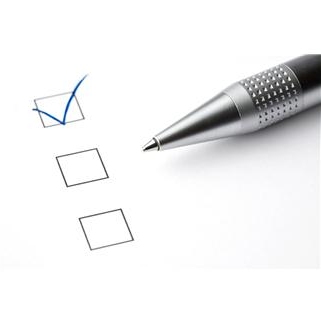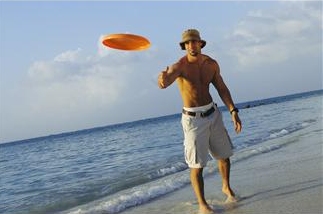 |
A few examples may help to make the point. Babe Ruth, a famous left-hander, batted and threw left, but he wrote with his right hand. Likewise, Martina Navratilova served left but wrote right. Left-swinging golf champions Phil Mickelson, Mike Weir and Steve Flesch all prefer their right hands for almost all other tasks. Conversely, right-handed golfer Arnold Palmer performs most non-golfing activities left-handed. Bill Gates writes his cheques with his left hand, but performs all other activities (including using a mouse) right-handed. Ex-US President Gerald Ford supposedly wrote left-handed when sitting down and right-handed when standing up!
Where on the spectrum of handedness can these individuals be said to lie, then? To take another example, Ronald Reagan, possibly left-handed by nature, was forced to become right-handed as a child, and is often considered functionally ambidextrous. Should he be considered left-handed, right-handed or both (or neither)?
Defining handedness, then, is clearly not as simple as noting which hand a person writes with, although this is probably the most obvious and visible display of handedness, and the one used most often in informal situations. However, the ambiguities and inconsistencies in arriving at workable definitions present a major challenge to serious researchers in the area. Many studies and comparisons (e.g. the association between handedness and schizophrenia, autism, developmental disorders, etc) are often based on different definitions of left-handedness, which makes the data very difficult to interpret and compare.
It is not sufficient to merely ask a person whether they are right- or left-handed. There are too many variables and uncertainties involved, which can too easily lead to anomalous results. For example, a person may have switched (or been forced to switch) from left- to right-handedness during childhood, or they may just respond with whatever answer they feel is expected. In Asia, the hand used for eating is considered a better guide to real handedness than the hand used for writing, as is more common in the West.
Just in passing, it is worth noting the logical difficulty of explaining or defining left and right, even in abstract terms. As long ago as 1768, the German philosopher Emmanuel Kant concluded, as have many others since then, that it is just not possible to explain the meaning of left and right using words alone and without referring to other concepts that already presuppose a knowledge of left and right.
Researchers usually assess handedness by one of two main methods:
- By asking a series of questions about which hand a person would usually use for various activities (testing for preference);
- By actually physically testing the relative accuracy and speed of each hand in a series of tests (testing for performance or efficiency).
The results of these two methods are often surprisingly different, although obviously there is a certain amount of overlap. It should be noted that there is something of a potential chicken-and-egg situation with skill and preference: does the preference exist because one hand is more skilled, or is that hand more skilled because it is the preferred hand (and therefore used more)? It seems likely, though, that handedness begins as a preference rather than as a skill difference, especially given the anecdotal evidence from people with malformed, disabled or missing limbs who appear to �want� to be right-handed but adopt left-handedness out of necessity.
 |
The �Big Three� tasks are writing, eating and throwing, and these alone are usually sufficient to define a person�s handedness for most simplistic purposes (although writing is also the handed activity most likely to be influenced by social pressures to conform). Other broader tests of laterality are often also incorporated into such tests, such as which eye a person uses to look through a camera lens, which foot they use to kick a ball, etc.
Strikingly different results can be yielded by different test questionnaires, and the potential biases introduced by phrasing and language become readily apparent. For example, two different tests may classify the same person as left-handed or as �weak right-handed�.
There are several kinds of errors which routinely creep into such tests. For example, people often tend to respond in the way they think the questioner would expect, the way they think they ought to answer; sometimes they may err in the other direction, offering the researcher a deliberately non-conformist answer they think he will find interesting, even if it is not actually accurate; or they may just answer incorrectly in good faith, having no real idea of which hand they typically use for specific tasks.
The most commonly-used handedness survey today is the Edinburgh Handedness Inventory, a simplified questionnaire designed by R.C. Oldfield, but based on a more detailed questionnaire originally created by the English psychologist Marian Annett in 1970. You can test your own handedness with an online questionnaire based on the Edinburgh Handedness Inventory here or here.
Measuring actual hand performance, is usually considered to be a more accurate, objective and unambiguous guide to handedness (based as it is on hand use, which in turn takes into account preferences), although it may not always be as practical or economical. However, even here, errors can creep in, especially when one considers that any superior performance of one hand over the other is relatively small, usually of the order of about 10% (e.g. the right hand is 10% faster or more accurate than the left).
Examples of performance testing include: the Purdue Pegboard Test (which measures speed and accuracy in placing small pegs in holes, and then small rings on those pegs); measurement of the speed and accuracy of tapping on a keyboard-type set-up or a mechanical tapper; speed and accuracy of operating a computer mouse; speed and accuracy of marking dots within small circles; measurement of grip strength; measurement of hand and arm steadiness (using a game like Operation or an electronic hand steadiness game); etc. With all of these, both hands are tested separately and the comparative performance of the left and right hands measured.
The choice of measurement method or how the results are assessed may depend on the purpose of the testing. For example, sometimes the important response may not be whether the left or right hand is preferred, but how ambiguous or inconsistent the choice of hand is. This may be a more appropriate test, for example, for the developmentally disabled or delayed, who are much more likely to �flip-flop� between hand choices, or to have difficulty choosing one or the other. Such individuals, who exhibit what might be called �conflicted handedness�, may also be more at risk from conditions like schizophrenia.
Other aspects of laterality can also be tested quite simply. For example, footedness is easily established by noting which foot is instinctively used to kick a ball. Ear preference is quite effectively tested by noting which ear tends to be used to listen on a telephone. Eye preference can be tested as simply as by noting which eye is used to look through a keyhole or a camera viewfinder. But another good test of "eyedness" can be carried out as follows: point with one finger at a distant object with both eyes open; then close one eye; if the finger is still well aligned with the object then the open eye is the dominant one (closing the other eye should then reveal that the finger is no longer closely aligned with the object).
